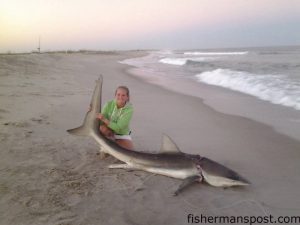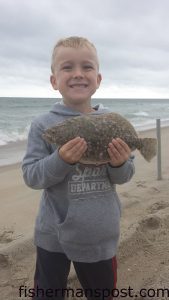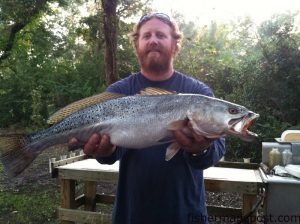Carolina Beach – Winter 2014-2015
Zach, of Island Tackle and Hardware, reports that anglers are connecting with speckled trout around Carolina Beach Inlet and in the Cape Fear River at present. The inlet is producing big numbers of fish, but most have been undersized lately so anglers pursuing the larger fish have been focusing their efforts on the Cape Fear River.
The best action has been around the grass islands from Snows Cut south. Live shrimp fished under floats are the top trout foolers but those tossing artificials are finding success with MirrOlures and a variety of soft plastic baits.
The speck bite slows a bit as the water temperatures fall, but the fish should be around for most of (if not the whole) winter.
Red drum are looking for meals on the mud flats off the lower Cape Fear (most undersized but some slot fish). They’ll bite a variety of cut and live baits or artificials like Gulps and other soft plastics.
Pleasure Island surf casters are fooling decent numbers of black drum while baiting up with shrimp and Fish Bites baits.
Good numbers of gray trout are looking for meals just off Carolina Beach Inlet and at nearshore structure within a few miles of the beachfront. They’ll bite a variety of live and dead baits, soft plastics, or metal jigs like Stingsilvers.

Carly Hagg with an 8’9″ (est. 170 lbs.) dusky shark that she landed from the beach at Fort Fisher on a kayaked bait. She also removed a shipping strap entangling the shark’s head and gills before releasing it.
Robert, of Carolina Explorer, reports that anglers are connecting with red drum and speckled trout in the bays and backwaters off the lower Cape Fear River. Both are falling for Gulp shrimp, soft plastic paddletails and jerkbaits, and live shrimp and mud minnows pinned to 1/8 and 1/4 oz. jigheads.
Black drum are feeding in many of the same areas and falling for fresh shrimp on bottom rigs.
The red drum action should remain strong throughout the winter months, and the fish often provide some exciting sight-casting opportunities in the season’s particularly clear water. The black drum and speck bite tends to slow down as the water gets truly cold, but anglers will encounter a few of both fish while chasing the reds in the cold.
Jeff, of Seahawk Inshore Fishing Charters, reports that the area fishing has been excellent lately, with large schools of red drum feeding on the flats off the lower Cape Fear River. Anglers are hooking the fish while working Gulp shrimp and paddletail D.O.A. soft plastics across the flats. Smaller schools of fish are feeding in the adjacent creeks and presenting some exciting sight-casting opportunities to anglers casting the same baits.
Tossing live shrimp and mud minnows into deeper potholes in the creeks is also producing plenty of action with the reds, particularly on lower tides.

Baylor Harris (age 6), of Burgaw, NC, with his first flounder, hooked on a piece of squid in the Fort Fisher surf.
The red drum action should stay consistent all winter long.
Black drum are feeding alongside the reds in the creek holes and also pouncing on live shrimp. Anglers may also run into the black drum looking for meals around oyster points at higher tides.
Some fat speckled trout are feeding in the creeks, too, and around grass islands and oyster points in the main river. The specks are falling for a variety of soft plastics along with suspending baits like MirrOlure MR17’s.
A few flounder have been mixed in with the trout and reds (some keepers) and falling for the same baits.

